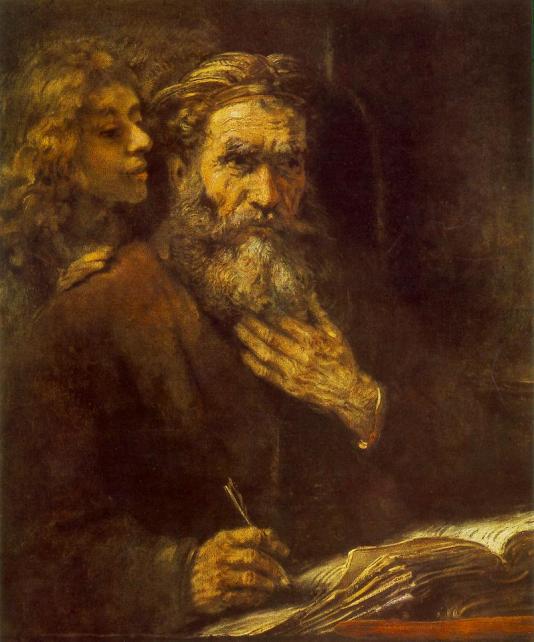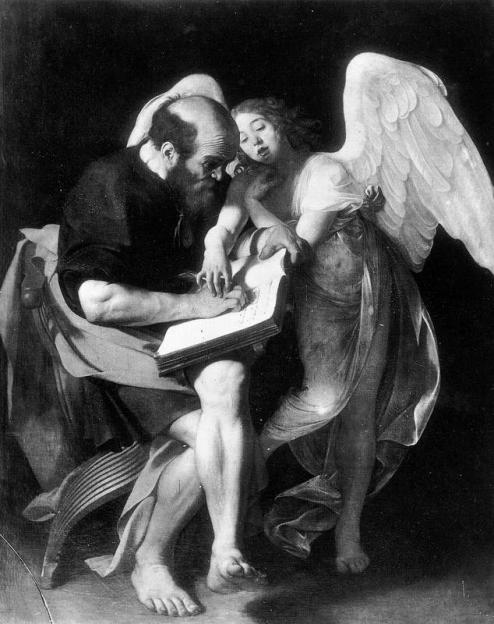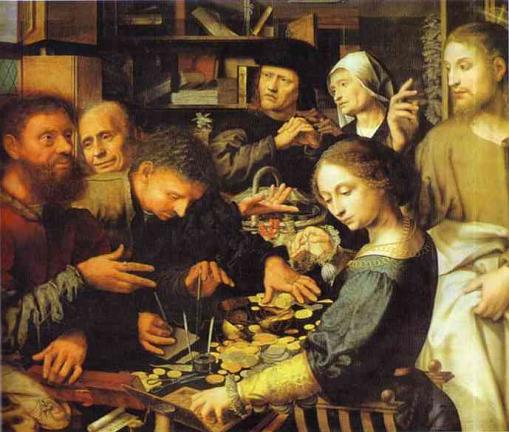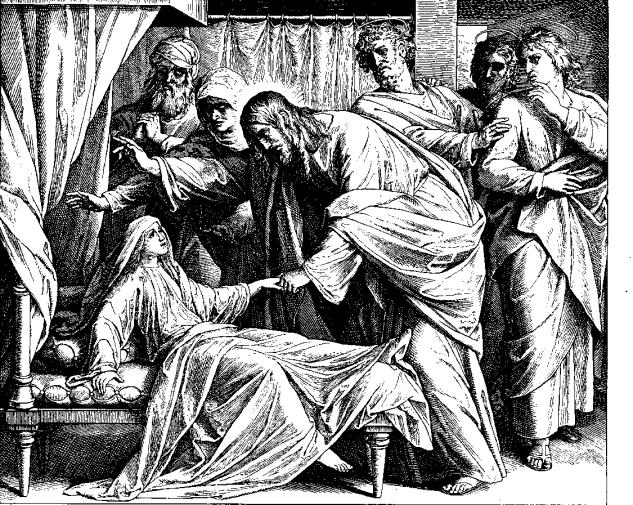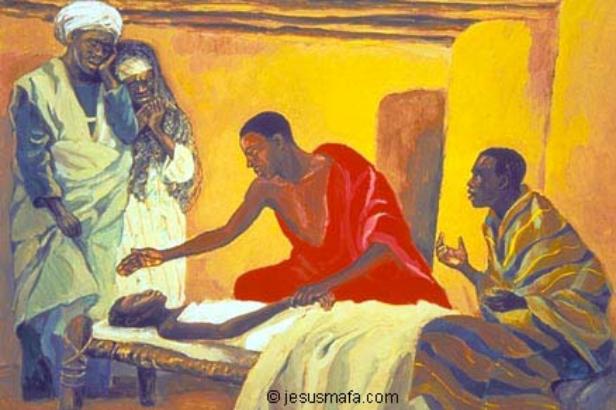
Christmas
Easter
Pentecost
All Saints
Christ The King
Confirmation
Palm/Passion
Reformation
Stewardship
Books of the Bible
Lenten Series
Christmas Dramas
Videos
Series A - Matthew
Series B - Mark
Series C - Luke
Series D - Other
To contact
Edward F. Markquart
info@sfs.com
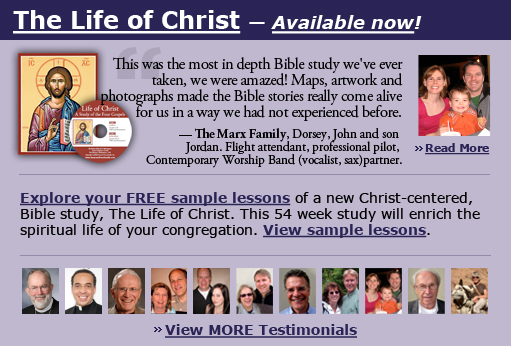
Pentecost Gospel Analysis, Matthew, The Tax Collector PENTECOST
2A
Matthew 9:9-13 SYNOPSIS OF THE
FOUR GOSPELS, Kurt Aland, English Edition, p. 42. PASTOR EDWARD F.
MARKQUART This Bible study
is from THE LIFE OF CHRIST: A Study in the Four Gospels. This 54 week course for the laity will be available for congregations
beginning in 2005. #44 THE CALL OF
LEVI (MATTHEW) Matthew 9:9-13; Mark 2:13-17; Luke 5:27-32 Like
all stories, this is another good story in which to look carefully
at the details that help us appreciate the fullness of the story. -Jesus
went out again beside the sea; the whole crowd gathered around him,
and he taught them. The sea in the text is the Sea/Lake Galilee.
http://www.christiananswers.net/bibleplaces/home.html -As he
was walking along, he saw Levi son of Alphaeus sitting at the tax
booth, Levi was a tax collector.
Tax collectors were hated and despised in Jesus’ day. These Jewish
tax collectors were working for the Romans by collecting Roman
taxes. The tax collectors made a healthy commission by tax
collecting and they were the richest people in town. There were
several Roman taxes: a ground tax on which a Jewish farmer paid 10%
of his grain and 20% of his fruit to the Romans; an income tax of
1%; a poll tax just for living; a travel tax to travel on Roman
roads; an animal tax to take your animal on the Roman roads, etc.
One Biblical commentator says that “tax collectors were
universally hated and notoriously dishonest.” The tax collectors
were disbarred from attending the synagogue and they were considered
unclean by the Jewish law. The
Jews of that era looked down on tax collectors. We recall in Luke
18:11 that “The Pharisee stood up and prayed about himself: 'God,
I thank you that I am not like other men-robbers, evildoers,
adulterers-or even like this tax collector.” In other words, tax
collectors were in the same category as robbers and adulterers. We
also think of Matthew 18:17 which says, “And if he refuses to
listen even to the church, treat him as you would a pagan or a tax
collector.” In other words, kick the guy out. Don’t have
anything to do with him. Ostracize him. Also, some Biblical scholars conclude that Matthew was the collector of the literary materials that were added together to compose the Book of Matthew. Matthew himself may have been the author of Special M, those special verses that are found only in Matthew. Matthew would have relied heavily on the outline and content of the Gospel of Mark (coping 91% of Mark), plus the teaching document called Q, and the Special M material. As a tax collector, he would know how to write, unlike the fishermen who were Jesus’ disciples. An Early Church Father by the name of Irenaeus (200 CE) concluded that Matthew, the tax collector, was the “author” of the “Hebrew book,” the Jewish Gospel of Mathew. This painting is by
Rembrandt. Notice the book in the painting. The book is symbolic of
Matthew being the final collector (author) of the Hebrew gospel
which was written especially for Jewish people. Notice the
“angel” behind Matthew. The “angel” is symbolic of the angel
giving Matthew the message of the gospel. http://www.wga.hu/frames-e.html?/art/r/rembran/painting/biblic2/matthew.jpg
The following painting is by Caravaggio. Notice that book which is symbolic of Matthew being the author (final collector) of the Gospel of Matthew. Notice the angel or messenger. Notice the angel’s hand on the hand of Matthew. It is as if the angel is guiding Matthew as he writes his gospel. http://www.wga.hu/frames-e.html?/html/c/caravagg/04/25conta.html
-And he said to
him, "Follow me." And he got up and followed him.
We assume that Matthew previously knew Jesus and heard and seen him
talk on other occasions. The invitation to discipleship was follow
Christ and Matthew did. We, too, are to follow Christ, to walk in
his footsteps, to follow his path of love. Circle he words,
“follow me.” That is what disciples do: we follow Jesus. See the painting
below. Jan Sanders van Hemessen. Jesus Summons Matthew to
Leave the Tax Office. 1536. Oil on panel. Alte Pinakothek,
Munich, Germany. We can see that the painter envisioned Jesus and
Matthew in sixteenth century German customs. http://www.abcgallery.com/H/hemessen/hemessen4.html
-He left
everything. Only in Luke. Highlight. Notice that Luke again
emphasizes that Matthew “left everything” and followed Jesus.
Similarly, in Luke 5:1-11, p. 22 in the SYNOPSIS, we notice that the
first disciples “left everything” and followed Christ. In
Luke’s version of the story of the rich young ruler, Luke 18:22,
p. 218, notice that only Luke has the rich young ruler
selling all that he has. When we finally get to Luke’s book of
Acts and the lives of the early Christians, we will find these early
Christians selling their possessions and giving the gifts to the
poor. Luke seems to be building his description of radical
discipleship in which a Christian shares generously of his/her
material possessions with the poor. Some Christians and
churches have interpreted these sections of the Bible literally e.g.
“sell all you have and give to the poor.” The result is
“medieval monasticism” where monks sell all their property in
order to be monks/priests who pledge “poverty, chastity, and
obedience.” Throughout history, certain Christians have
interpreted these passages to mean to God wants us to live a life of
poverty. I am not one of them. -And
as he sat at dinner in Levi's house, The gospels tell us that the scene has changed in
this story, and it is now at the home of Matthew and that Matthew
has prepared a great feast. It seems that this conversation was held
in the house belonging to Levi, the tax collector. -Many
tax collectors and sinners were also sitting with Jesus and his
disciples—for there were many who followed him. So it wasn’t just Matthew who was present. There
were a whole group of tax collectors present with other sinners. How
did the other tax collectors get there? They were invited. By whom?
By Matthew, we assume. Matthew had gone out to other tax collectors
and told them about Christ and invited them to his own home for a
meal with Jesus to see for themselves who this Jesus was. It reminds
us of the story of the “Samaritan woman at the well” and her
invitation for her friends to come and see this Jesus. -When
the scribes of the Pharisees saw that he was eating with sinners and
tax collectors,
Again, in so many of the stories about Jesus, there is a
conflict set up and this conflict is between the legalistic
righteousness of the Pharisees/scribes and the “so-called”
unrighteousness of the tax collectors/sinners. This is the first of
innumerable conflicts between Jesus and the Pharisees. This
encounter is the first one. -They
said to his disciples, "Why does he eat with tax collectors and
sinners?"
This is at the heart of the story. We recall the previous
comments about tax collectors who were hated and despised in
Jesus’ day. Jesus seems to consistently be drawn to the people of
the land, the downtrodden, the poor, maimed, blind and lame
(according to Luke), the outcasts, the lepers, the demonics,
epileptics, and paralytics. None of these people were part of the
religious establishment nor were they found in the synagogue on
Friday night because they were excluded from the synagogue for
various religious reasons. Such people were considered
“sinners.” When
Jesus heard this, he said to them, "Those who are well have no
need of a physician, but those who are sick; I have come to call not
the righteous but sinners."
This teaching too is at the heart of the story. This is why
this particular story is included in this place. The story is
ostensibly about Matthew’s call to discipleship, but the reason
this story is placed in this location among the other healing
stories is that sick people need a doctor. Jesus became known as the
Great Physician because Jesus healed both sick bodies and sick
souls/emotions/minds. Jesus came to heal those who were sick
physically and sick emotionally/spiritually/mentally. Some people do
not think that they need the healing of Christ; others do. Jesus
wants us to see ourselves as people who need the healing powers of
Jesus in our lives. -Go and learn
what this means. I desire mercy and not sacrifice.
(only Matthew) Matthew’s gospel, appealing to a Jewish audience,
once again quotes from the Old Testament, from Hosea 6:6. The
Pharisees and their scribes had defined their religion by doing the
sacrifices, obeying the Jewish laws and traditions, and following
letter of the law of their Bible, especially the Law/Torah. (The Law
is composed of five books of the Bible: Genesis, Exodus, Leviticus,
Numbers and Deuteronomy.) We Christians can become like the
Pharisees of old and obey our Christian traditions, Christian laws
and Christian interpretations that become more important than being
merciful like God/Jesus. The word, “sacrifice,” is symbolic of
religious rituals, religious traditions, religious interpretations
which become more important than everyday, common mercy that people
can give to one another. A fundamental problem for the Old Testament
prophets was that people “did religion” as a substitute for
doing justice and righteousness for the needy. The same problem
exists today when people “do the church thing” as a substitute
for doing mercy in our world around us.
-I came not to
call/invite the righteous but sinners.
Highlight. The word,
“call,” can also be translated “invite.” Jesus did not
invite people who thought they were righteous but people who knew
their need of God. Similarly, with us as Christians, we are to
extend our invitation to know and follow Christ to those who know
their need of Christ/God in their lives This is the first New Testament passage quoted by the early church fathers as Scripture. -To repentance.
(Only Luke) Luke likes the word, “repentance,” and inserts in
here. We are to turn from our sins. SERMON POSSIBILITIES
*It
seems wise to focus on the Call of Levi/Matthew and save the second
part of the text for next year, Pentecost 3B. Pentecost 3B focuses
on the next unit of Scripture, #95, Jairus’ daughter and the woman
with the hemorrhage. Both parts of the text are classic stories and
each part of the text deserves a sermon on it. *The story itself about the call of Levi/Matthew is powerful and needs to be retold. *There are statements in the story which are memorable: “Those who are well have no need of a doctor but those who are sick. I have come not to call the righteous but sinners, those who know they are in need healing.” *”Learn
what this means: I desire mercy and not sacrifice.” #95. JAIRUS’
DAUGHTER AND THE WOMAN WITH THE HEMORRHAGE
Matthew 9:18-26, Mark 5:21-43, Luke 8:40-56 P. 84. Context: We are
studying a sequence of four stories: the stilling of the storm, the
Gadarene Demoniac, Jairus’ daughter, and the woman with the
hemorrhage. See pages 122-125 in the SYNOPSIS. We find this sequence
of four stories in all three gospels, Mathew, Mark and Luke. These
four stories belong together as a series. The story is told in detail in all three gospels. Each gospel offers a unique perspective. The details from
this story are superb and make for colorful storytelling. - When Jesus had crossed again in the boat to the other side, a
great crowd gathered around him; and he was by the sea. Jesus
returned from the Decapolis, perhaps to the village of Capernaum and
to the synagogue in his own hometown. Mark says that “they were
beside the sea” and there were not many villages on the shores of
the Sea of Galilee. Capernaum was a village on the shores of the Sea
of Galilee. -Then
one of the leaders of the synagogue named Jairus came and, when he
saw him, fell at his feet and begged him repeatedly, Mark’s
gospel tells us that Jairus was one of the rulers of the synagogue.
Jairus was an important person in his community. From Biblical
scholars, we learn that Jairus was not a teacher, rabbi or political
member of the ruling Sanhedrin, but that he was the presiding leader
of the synagogue. That means, he was responsible for worship e.g.
appointing those who read the Scriptures during worship, prayed
during worship, and taught during worship. It also seems that he may
have been wealthy or a person of economic means. The synagogue was
the most important institution in a local Palestinian village, and
Jairus was the presiding officer of that synagogue which meant that
Jairus was the leading citizen of his village. But, being the
presiding official of the synagogue, did not protect Jairus from the
evil vicissitudes of life. Jairus may have been
“super-successful” in the eyes of his world, but this did not
insulate him from one of the most devastating tragedy he could
experience, the death of his only daughter This man fell as
Jesus’ feet and begged him. To fall at someone’s feet and to beg
him is a sign that you desperately need what that person has to
offer At this point in
Jesus’ life, the leaders of the synagogues were not deeply hostile
to Jesus. Rather than being hostile to Jesus, this man was desperate
for the healing power that lived in Jesus. -"My
little daughter is at the point of death.” “My
little daughter, my only daughter, my twelve-year old daughter.”
We know how precious all of our children are to us, but when a child
is your only child, the potential loss of that child becomes
increasingly painful and poignant. Mark tells us the daughter was
Jairus’ little daughter; Luke informs us that this was his only
daughter and that she was twelve years old and was dying. What
tragedy. In Jewish society of that era, a twelve year old girl was
on the edge of becoming a young woman who was soon to be married.
But Jairus’ little girl was not maturing into her young
future but her life was going to be snuffed out prematurely. As
human beings, we can imagine Jairus’ inner fear, pain and
consuming sadness. -“Come
and lay your hands on her, so that she may be made well, and
live."
The ruler of the synagogue deeply believed that Jesus could heal his
little girl. Jairus was on his knees and begging for Jesus to help
her, to heal her. Once again, as we have in previous stories, we encounter great faith. We remember the centurion’s slave/or son who was deeply sick and we remember the deep faith of the centurion that Jesus could heal his slave. This story is another “great faith” story. -So he went with him. And a large crowd
followed him and pressed in on him. -Now
there was a woman who had been suffering from hemorrhages for twelve
years. In the middle of the story of Jairus and his dying
daughter, we encounter another story. Here was a woman who had been
hemorrhaging for twelve years. According to Jewish law (Leviticus
15:25-27), she was declared to be unclean. That means, she was to be
cut off from attending the synagogue service of worship and also cut
off from her friendship patterns. She was to be ostracized from
being part of Jewish society. We also learn from Biblical historians
that the Jewish Talmud describes eleven different cures for this
common disease. We can imagine the devastation of being declared
unclean for twelve years. That means, she had been living in
isolation for a long, long time. -She
had endured much under many physicians, and had spent all that she
had; and she was no better, but rather grew worse. Many
people today have similar experiences. That is, many people visit a
great variety of doctors, trying to find a cure. Many people today
spend much of their money on doctors and become medically poor. Many
people today do not get better but worse. In ancient days with
ancient medicine, we cannot even begin to imagine the primitiveness
of medical treatment and its consuming costs. This woman had spent
all of her earnings on medicine and was worse for it. -She had heard about Jesus, was no better but rather grew worse. “She
had heard about Jesus.”
There are times in life when we hear about Jesus and what Christ can
do for us. This woman had heard reports that the power of God in
Jesus could heal her. We also need to spread reports to our family,
friends and communities about how Jesus has healed us in our
situations. When other people may hear those reports, they may come
to Christ, the Presence of God, and Christ may heal their lives as
well. -And came up behind him in the crowd and touched his cloak, for she said, "If I but touch his clothes, I will be made well." This woman’s faith was almost superstitious. That is, if she touched his hankie, his garment, the fringe of his garment, his hand, she would be healed. Her faith seems to have been a superstitious faith but that didn’t’ stop Jesus from healing her. Very often, our faith does not measure up to the church’s definition of a high quality of faith. This woman’s faith was not complex, theologically sophisticated, or religiously stylish. Rather this woman’s faith was simple and seemingly superstitious, and that was OK with Jesus. Focus on
the word, “fringe.” This word can also be translated,
“tassel,” and in Jesus’ day, there were four tassels at the
bottom of the outer garment. Today, those tassels can still be seen
on Jewish prayer shawls. -Immediately her hemorrhage stopped;
and she felt in her body that she was healed of her disease. -Immediately
aware that power had gone forth from him, In spite of the
crushing mob of humanity around Jesus, pushing and pulling and
touching him, Jesus knew that this woman had touched the hem of his
garment and the power of God had gone out from him to heal this
woman. Jesus was filled with the power of God, the power of the Holy
Spirit, the power of the healing and compassion, and this power went
out from Jesus. We also hear in Acts 1:8 that this power will be
given to us as Christians, that we too have the power of God inside
of us. No, not a power that is the same as the power in
Jesus, but a power similar to Jesus. Within us, there is a
power to heal, a power to love, a power to help cure the ills of the
world. … Also, many of us feel the same thing from people of
enormous giftedness e.g. wanting to touch Mother Theresa’s hand or
shake hands with Nelson Mandella or Abraham Lincoln or a host of
other famous and gifted people. It is our desire that that special
qualities in them would rub off on us. -Jesus turned about in the crowd and said, "Who touched my clothes?" William Barclay, in his commentary on the book of Matthew, is at his best when he writes: “When she touched it, it was as if time stood still. It is as if we were looking at a motion picture, a film, and suddenly the picture stopped and left us looking at one scene. The extraordinary and movingly beautiful thing about this scene is that suddenly in the midst of the crowd, Jesus stopped, and for the moment, it seemed that for him that no one but the woman and her need existed.” “For Jesus, no one ever is ever lost in the crowd.” And God is
like that. Barclay goes on to tell a story about the sinking of the
unsinkable ship, Titanic, in April of 1912.
The next day, the headline of a famous newspaper was devoted
entirely and exclusively to the death of the multimillionaire, John
Jacob Astor. At the end of the article, the newspaper almost
casually mentioned the other 1800 people who died. The other 1800
were not that important. Such is the attitude of the world and many
public media, but not God, the Father of our Lord Jesus Christ. The
Lord is concerned about every single person and no person is lost in
the crowd, however unimportant that person may be in the eyes of the
world. -And his disciples said to him,
"You see the crowd pressing in on you; how can you say,
"Who touched me?' " He looked all around to see who had
done it. -But
the woman, knowing what had happened to her, came in fear and
trembling, fell down before him, and told him the whole truth. We can see this woman. Simon Peter was at his best as he was
retelling this story. The woman approached Jesus, shaking with fear
and fell down before him and told it all. She told him the whole
truth about what she had done. That
is what God wants from us. God wants to tell God the whole truth
about ourselves and our need for healing. Like
Jairus with his dead daughter and the centurion with his sick
slave/son, this woman too was desperate and she needed the healing
of Jesus. So we see three unique kinds of people and three unique
shapes of faith: a Roman centurion, a presiding officer of the
synagogue, and a sick woman who was the poorest of the poor of her
society. Three stories. Three people. Three different shapes of
faith. But all believing that Jesus could bring healing to their
lives. -He said to her, "Daughter, your faith has made you well; go in peace, and be healed of your disease." As with the other stories, we are again encounter the power of faith in Jesus and how that power of faith is part of a cure. A question almost always rises: “How about people who have deep faith in Jesus and his healing power and those people were not healed? How do you explain that?” We have dealt with this question many times in our lives, and we deal with it especially during those times when our family member or friend is sick and they are not being healed physically. Or, maybe that person is yourself or myself who is not being healed. We often ask: “What is wrong with my faith? How come I am not being healed? How come my loved one is not being healed? Do I not believe enough? Do they not believe enough?” As human beings, we are forever asking those questions, even when we are older and supposedly more mature. It is a condition of our humanity to ask such questions because all human beings ask them at sometime or another. And we all know the answer. That is, not every one is emotionally or physically healed, regardless of the depth and sincerity of our faith and our prayers. Life does not work that way. When a
person is not healed physically, we ask other prayers e.g. “God,
give that person (or myself) the strength and wisdom we need for
living with this infirmity. Help us to handle this awful situation.
Please God, we need your strength and wisdom to face what life is
giving to us.” -While
he was still speaking, some people came from the leader's house to
say, "Your daughter is dead. Why trouble the teacher any
further?" Now, we are back to the original story. We
have finished the story within a story, and now we are back to the
first plot. Jairus’ daughter. She is dead. Do not bother Jesus
anymore because Jairus’ only daughter has died. -But overhearing what they said, Jesus said to the leader of the synagogue, "Do not fear, only believe." We can imagine Jairus’ fear, for fear is our primary human emotion when we hear the bad news of cancer or the bad news of death. Our hearts explode with fear, panic and being stunned. So it was for Jairus. Yet Jesus said not to fear but only to believe. Once again, we hear Jesus inviting us to “only believe.” To only believe in God, to only believe that there is life after death, to only believe that God is with us in every circumstance, to only believe. Yes, we as human beings want to “only believe” but our reason and instincts seem to feed the doubts in our minds. We know if we “only believed,” life would be better/healthier for us. -He allowed no one to follow him except Peter, James, and John, the
brother of James. This is the first time in the Jesus Story that we hear about Peter,
James and John as being the select, inner group of Jesus’
disciples. Peter was telling the story to John Mark and Peter names
himself at the top of the list. There are
several times in the gospel stories that we hear about the “big
three” disciples, the important three, the three that seem to have
a special position among the twelve disciples.
Peter, James and John are at the Mount of Transfiguration,
the Garden of Gethsemane, and here in the privacy of Jairus’ home
to see the raising of Jairus’ daughter from the dead. -When
they came to the house of the leader of the synagogue, he saw a
commotion, people weeping and wailing loudly. Flute
players were common at ancient ceremonies of grief for both the Jew
and the Romans. The wailing music off the flute was associated with
death, and Roman law limited the number of flute players at a
funeral to ten. In that ancient Jewish culture, there were
“professional” wailers and weepers, those people whose position
in society was to weep and mourn at funerals. The wailers and
weepers were already there, raising a tumultuous fuss. -When he had entered, he said to them, "Why do you make a commotion and weep? The child is not dead but sleeping." When someone dies, we occasionally say that they are sleeping or that they have “passed away’ or “slept away.” The British scholar, Barclay, says that there is a Greek word that describes death as sleeping, but that Greek word was not used here in this context. Rather, the Greek word for sleeping in this text means just that: “the young girl was sleeping.” Barclay also says that deep/deathly comas were common at this time in history; that burials occurred quickly in the hot Palestinian climate so that the body did not deteriorate; and that people were not infrequently buried alive when they were in a deep coma. For Barclay, this story is an example of “divine diagnosis” as much as it is an example of “divine healing.” Jesus diagnosed the young girl that she was in a deep sleep of a coma, and Jesus raised her from that coma and saved her from being buried alive. This story is an example of Jesus delivering a person from death. Respecting Barclay’s analysis, it seems that the people of Jesus’ day would simply have declared that Jesus raised this young girl from the dead. -And they laughed at him. Circle, underline, highlight. Yes, there are still people
who laugh at Jesus. But I don’t think many. That is, the crowds
may laugh at us Christians and the imperfections and sinfulness of
our lives, but I sense that people “out there” do not laugh at
Jesus. In our western world, Jesus has become a majestic symbol of
goodness, spirituality, love and justice, even if people don’t
believe in him as the Son of God. -Then he put them all outside, and took the child's father and
mother and those who were with him, and went in where the child was.
Only
the mother, father, and the three disciples were with him in the
room where the child was. Jesus was not going to “show off” his
healing powers for the crowd who wanted a “Houdini healer from the
Holy Land” to put on a show. -He took her by the hand and said to her, "Talitha cum," which means, "Little girl, get up!" “Tabitha cumi” is an Aramaic expression for “maid” or “little girl.” We find that Jesus also spoke an Aramaic phrase from the cross, “My God, My God, why have you forsaken me.” Peter would have been the source of this Markan story. We do not know why Matthew and Luke do not include this Aramaic phrase in their version of the event. -And immediately the girl got up and began to walk about (she was
twelve years of age). The miracle occurred. The daughter was raised from her coma like
sleep, from her death. -At this they were overcome with amazement. When you experience a miracle in your life, you normally are amazed at the marvelous gift that God has given to you. We are all amazed when we hear stories of God delivering people from the jaws of death. -He strictly ordered them that no one should know this, and told
them to give her something to eat. Persistently, we have heard Jesus try to keep the news of
his healing power quiet. Jesus knew that the crowds would follow him
for the wrong reason, and soon we will hear about thousands of
people clamoring around Jesus for healing, food and other miracles. PAINTING
AND IMAGINATION: JESUS RAISES THE YOUNG GIRL FROM DEATH http://www.wels.net/wmc/Downloads/184.gif
http://www.faithcentral.net.nz/inclass/art/digest7.htm http://www.jesusmafa.com/anglais/imag25.htm
SERMON POSSIBILITIES+It seems
wise to focus on either the story of the call of the first disciple or
the healing of Jairus’ daughter and the woman with the hemorrhage
for twelve years. +The second story (Jairus’
daughter, sick woman) is the focus on a sermon text for Pentecost
3B.
|


